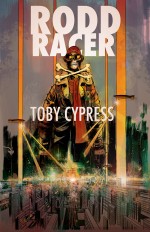 Toby Cypress has amassed a nice set of original work in recent years with acclaimed contributions to books like The Tourist, Popgun, Marvel’s Strange Tales II, and this year’s Blue Estate. It was with the recent book Rodd Racer that I finally fully realized why he’s such a respected creator. As one who processes and writes about new comics every week for this blog, I’m always looking for a new book to capture my attention and remind me why I still love comics. On a first read, Rodd Racer succeeds for me because it pays homage to racing strips of the fifties and sixties, with characters like Frank Frazetta’s Johnny Comet serving as one antecedent. In the same way that Cypress respects the visual traditions of the racing strip, his narrative work doesn’t branch too far away from those original narrative structures. The resulting effect is one of instant gratification, whereby readers can enjoy Cypress’ visual craft while remaining unencumbered by an overwrought story.
Toby Cypress has amassed a nice set of original work in recent years with acclaimed contributions to books like The Tourist, Popgun, Marvel’s Strange Tales II, and this year’s Blue Estate. It was with the recent book Rodd Racer that I finally fully realized why he’s such a respected creator. As one who processes and writes about new comics every week for this blog, I’m always looking for a new book to capture my attention and remind me why I still love comics. On a first read, Rodd Racer succeeds for me because it pays homage to racing strips of the fifties and sixties, with characters like Frank Frazetta’s Johnny Comet serving as one antecedent. In the same way that Cypress respects the visual traditions of the racing strip, his narrative work doesn’t branch too far away from those original narrative structures. The resulting effect is one of instant gratification, whereby readers can enjoy Cypress’ visual craft while remaining unencumbered by an overwrought story.Sometimes a creator working within a specific sub-genre might be tempted to elaborate on certain elements of a story, thus taking away from some qualities that made those stories work in the first place. Cypress’ story in Rodd Racer serves the purpose of this particular type of comic. The framework suggests a clear, simple backstory of a murdered mentor and a vengeful pupil, a strong female support role, and the inevitable symbolic and literal victory over the immoral. While there aren’t many unexpected plot twists, the natural progression and rhythm of the racing setting act as a wonderful palette for Cypress to explore elements of inky motion.

While Cypress clearly does a great job of achieving motion with his illustration skills, he also adds meter to the book’s momentum with his use of chapter headings. Aside from being the book’s only inclusions of color, the musical and lyrical quotes are intentionally placed to add to the feeling of movement. Aritists like The Misfits, Miles Davis, Beastie Boys, Television, and Art Blakey and the Jazz Messengers are all mentioned or quoted. The range from punk, to hip hop, jazz to rock signifies Cypress’ intelligent use of certain songs, genres, and musical forms to accompany the moods and tempos suggested by certain parts of the book. Visual rhythms harmonize with musical time signatures, creating a natural, built-in soundtrack for the book. At the same time, while operating seamlessly within the realm of comics, Cypress also shows us he has an awareness of the properties of film and storyboarding.
 Cypress’ greatest achievement with Rodd Racer is that both he and his readers are knowingly cognizant of the multiple ways a comics artist might convey the action of movement. In a way, the necessary sequential mannerisms of the comics form make it ideal for racing narratives. Cypress allows himself to stretch out and play with the spatial relationships of vehicles at high speed, and the passage of time from panel to panel, page to page.
Cypress’ greatest achievement with Rodd Racer is that both he and his readers are knowingly cognizant of the multiple ways a comics artist might convey the action of movement. In a way, the necessary sequential mannerisms of the comics form make it ideal for racing narratives. Cypress allows himself to stretch out and play with the spatial relationships of vehicles at high speed, and the passage of time from panel to panel, page to page.At the same time, Cypress turns the genre slightly on its ear by making the protagonist’s success dependent on the female lead character, thus subverting the damsel in distress or the strictly eye candy roles female characters were relegated to in the heyday of the racing strips. And while the book takes place in an unspecified time, the suggested dark, neon future portrayed reminds us that some stories might be cyclical, but don’t necessarily lose their entertainment value. Rodd Racer is a clear presentation of an artist who, before our eyes, deftly melds the work of his craft with the innate joy of comics. Check it out if you haven’t yet, and enjoy a solid stand alone volume from a talented creator.
author's note: This review also appears on the blog of Heroes Aren't Hard to Find (www.heroesonline.com).

No comments:
Post a Comment